When you’re new to scuba diving then choosing the right wetsuit can be confusing because you don’t know what thickness to choose, let alone the small features to look for.
About Wetsuits
Wetsuits work by trapping a layer of water next to your skin, your body heats this up and that water in return keeps you warm. The downside of this is that cold water must first flood into the wetsuit so you’ll feel a cold trickle of water entering the suit when you first jump in but it only takes a minute to heat up and the benefits can be felt. Wetsuits are generally made of neoprene and a good quality neoprene suit should last you plenty of years if you look after it.
The best way to ensure you buy a wetsuit manufactured using a good quality neoprene is to always purchase wetsuits from large scuba manufacturers like Fourth Element, Mares, Waterproof or Scubapro, not at your local supermarket or on the beach front.
Scuba diving suits are made differently than surfing suits and are made to resist the pressure and compression at depth so while surfing suits will crush and lose its warmth as you descend a good scuba wetsuit will stay warmer as you go down.
Today wetsuits are available in a range of configurations for different uses:
Shorty wetsuit – In the warmest water, a shorty wetsuit will be ideal, with short arms and legs where only the body is covered. Easiest to put on and take off Shorties are typically 2.5-3mm neoprene and allow freedom of movement too without sleeves.
Full-length steamer – This is essentially the same as a shorty wetsuit but these suits have full-length arms and legs. These suits offer additional warmth as well as extra abrasion protection in key areas and are ideal when diving near wrecks to avoid cuts and scrapes.
Neoprene Alternatives – Some people react to some neoprene or parts of wetsuits so there are wetsuit alternatives made from materials. Working in a similar way these alternatives trap water against your skin and stop it from flushing around inside but they tend to be neutrally buoyant and don’t suffer from compression however they only equate to a 2 or 3mm wetsuit.
Semi-Dry Suits – Semi-dry suits are a wetsuit with seals and features similar to a drysuit but they are made to allow some water in. These suits have ankle, wrist and neck areas made of a special material to reduce the flushing effect of warm water being washed out of the suit by cold water entering.
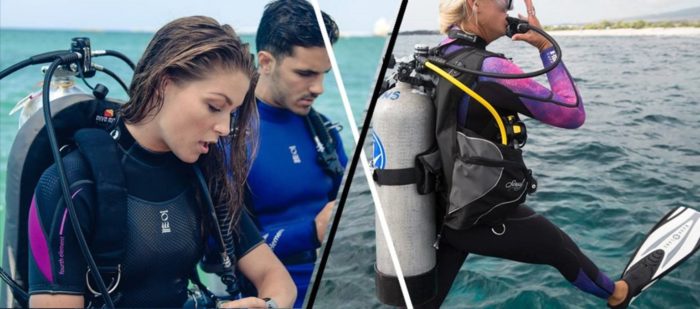
Thickness
As a general rule, there are 3 main thicknesses of wetsuit: 3mm, 5mm, and 7mm. The thinner the suit, the better flexibility of movement you will have but the less warmth and buoyancy. Thicker wetsuits are more buoyant and cumbersome so you trade flexibility for warmth.
To start with it all depends on how much you feel the cold so hold that in the back of your head when choosing a suit. If you do feel the cold then go up a thickness or add another layer to keep you warm. Logically it would make sense, if you feel the cold, to just buy the thickest wetsuit and you’ll be fine but while thicker wetsuits have their pros they also have their cons too.
| Pros | Cons |
|
|
Generally speaking:
- 3mm suits are ideal for the tropics
- 5mm steamer suits are ideal for the Red Sea and similar areas
- 7mm suits are suitable for UK summer diving
- Anything colder you are looking at dry suits with under layers as appropriate
We’ve come up with this chart to help you choose a suit for the location you’re planning on diving in:
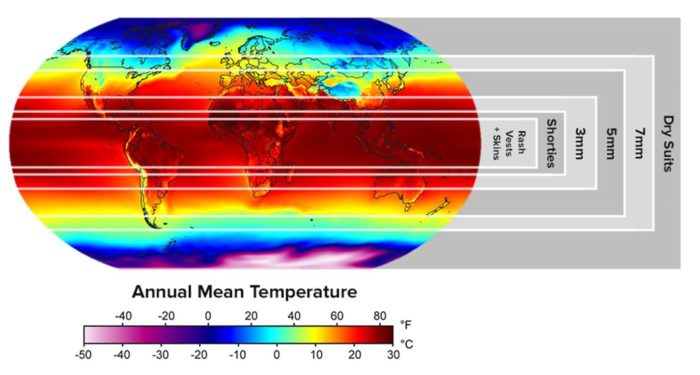
28°C and Over
If you’re lucky enough to be diving in waters above 28°C (~82°F) then you should be wearing a Rash Vest and swim shorts. In these warmer waters around the equator and tropics then there’s a good chance there’s lots of sun so you need a Rash Vest to protect you from harmful UV rays.
If you’re going deeper down, particularly feel the cold or plan on staying under for longer then consider looking at Shorties or even a steamer to add some thermal protection.
20 – 25°C
Over 20°C you’ll need a 3mm wetsuit to protect you but you can wear a thicker suit or layer up a shorty and a full length to stay warm. You can always wear a thicker wetsuit for more warmth but you will need more lead to stay down and need to consider the buoyancy shift at depth.
10 – 20°C
5mm suits are the most versatile thickness and can be worn down to about 10°C depending on what accessories and quality of suit you wear. You can wear a 5mm in the Red Sea in the colder months and the UK in warmer months but the closer you get to 10°C many turn to 7mm suits or layer up a 5mm shorty with a 5mm steamer. Gloves and Hoods will make a huge difference to your warmth in the water so if you’re diving in colder waters then consider both Gloves and a Hood.
10°C and Below
In cold water, you’ll need a 7mm, Semi-dry Wetsuit or a Drysuit to stay warm with Hood and Gloves too. If you’re diving in cold waters but don’t want a drysuit then a Semi-dry is the best option as they work just like a wetsuit but with features similar to a Drysuit.
Features
Wetsuits have quite a few subtle features built into them today that make them more effective and useful to the modern diver.
Warmer
Be on the lookout for these key features on a wetsuit that will make it warmer.
Seals
The edges of the suit around your wrists, ankles, and neck must be snug but not so tight that they cut off circulation. The most basic of seals is rolled neoprene which is either the edge of the neoprene folded over and sewn together so there isn’t a raw edge. These are ok but not the best at slowing water from flushing in and out of the suit but they are cheap to manufacture.
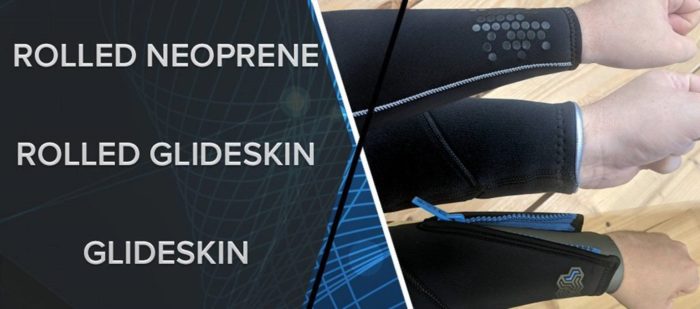
Rolled glideskin is a step up from basic neoprene. Look for a shiny grey lining that’s a little bit sticky to your skin as this material is very effective at creating a seal that lets some water through but slowly which is exactly what you want for a wetsuit. Rolled glideskin right on the cuff is pretty good at sealing that area but some suits have a Canadian style seal that is a circle of neoprene inside the suit on the forearm which is very effective at slowing water transit.
Higher end suits will have long sections of glideskin that create a long and wide seal along your wrist and forearm. These are the best due to the seal’s surface area but be careful with rings, long nails and tugging on glideskin as it can tear easier than lined neoprene.
Zipper
You have to get in and out of your suit and the easiest way is a zipper so on most suits you’ll find a zipper either on the back or front of the suit. The position of the zipper doesn’t affect the warmth but what’s behind it will. Behind the zipper you should find at least a small flap of neoprene that sits under the zipper and slows any water that comes in through it.
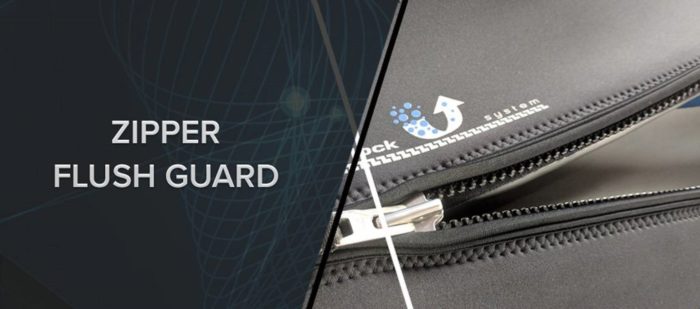
Some suits improve this guard with either more glideskin that create a better seal under the zipper or a whole section of neoprene that will cover your back and go around your neck like in the Fourth Element Proteus creating a whole barrier to keep the water away from you.
Stitching
It may seem boring but the stitching on your suit is very important. Lower-end suits you’ll find flatlock and overlock stitching which is pretty cheap to manufacture but allow water to creep through the neoprene.
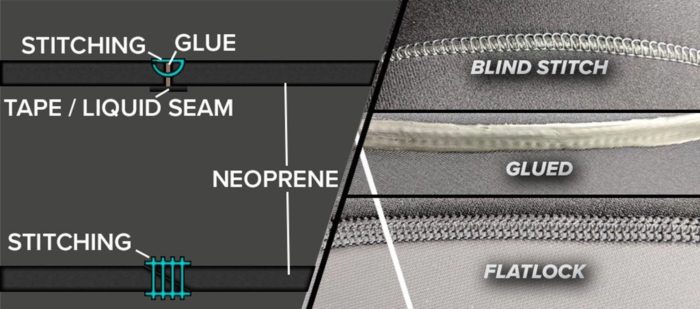
Blindstitch and glued seams are the best because the needle and thread don’t go all the way through and don’t create a path for water to seep through.
Convenience
A wetsuit doesn’t just have to be a skin-tight suit of neoprene they can have features on them that make your life easier in and out of the water.
Pockets
Thigh pockets mean you can take a spare mask or tools like a dSMB down with you. A pocket or two on your thigh means your gear isn’t dangling down off a D-Ring and it’s right where you want it when you need it.
Adhesive Spots
Certain spots around a wetsuit, usually the outside of the wrists and shoulders, will have a detailing on them that grips to things when wet. This is particularly useful for dive computers so they don’t slip around or down your wrist and your BCD shoulder straps to hold them in position.
Multi-thickness
Some suits will have different panels in key areas made from thinner neoprene. While thinner neoprene may not be as warm it is more flexible so these suits will have thick areas over the core of your body to keep you warm but where you need flexibility like under the arm and other joints so you can move better.
Wrist and Ankle Zippers
The seal around your wrists and ankles must be snug but if it’s snug then it can be tricky to get your hand or foot through but with zippers, you can get your hands and feet through easily and then zip them up so they’re snug, best of both.
Finally, a reminder that the best way to ensure you buy a wetsuit manufactured using a good quality neoprene is to always purchase wetsuits from large scuba manufacturers like Fourth Element, Mares, Waterproof or Scubapro, not at your local supermarket or on the beach front.
If you are interested in picking up your next wetsuit why not head to SimplyScuba.com who have an amazing array of Wetsuits as well as all your Scuba Diving equipment needs.
This is a sponsored post – for more information please see our disclosure policy.

